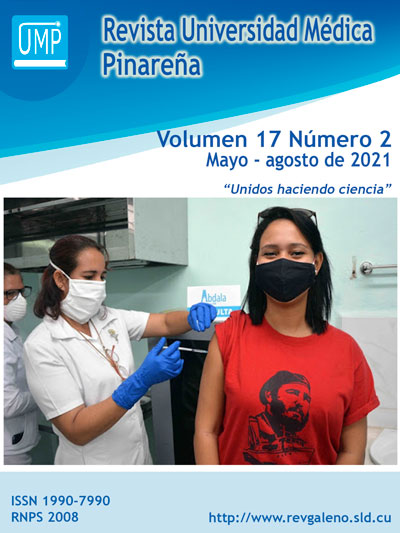Assisted reproductive techniques in the prevention of mitochondrial diseases
Keywords:
DNA, Mitochondrial, Mitochondrial Diseases, Reproduction, Reproductive Techniques.Abstract
Introduction: the mitochondrion is an important organelle that has its own DNA that is sensitive to mutations. These mutations can cause mitochondrial diseases, a heterogeneous group that suggests mitochondrial dysfunction.
Objective: to analyze the role of the use of assisted reproductive techniques in the prevention of mitochondrial diseases.
Method: a bibliographic review was carried out during May 2019 in SciELO, PubMed and ClinicalKey databases. Twenty articles were consulted using the combination of terms through searching procedures and theoretical methods of analysis-synthesis, induction-deduction and historical-logical methods were applied.
Development: part of the information required for the synthesis of mitochondrial components is encoded in the mitochondrial DNA. Mitochondrial diseases have no cure, although they can be avoided by a group of four mitochondrial replacement therapies that include pronuclear, spindle, primary polar body and secondary polar body transfer. However, these techniques can lead to adverse phenomena such as reversal, carryover and incompatibility between nuclear and mitochondrial DNA. The use of these techniques triggers multiple bioethical and social conflicts and a wide diversity of opinions despite their positive results.
Conclusions: mitochondrial replacement therapies derived from in-vitro fertilization procedures are available to prevent the transmission of mitochondrial diseases. These therapies have been experimentally supported and are not exempt from adverse biological phenomena. Professionals who advocate for these procedures face bioethical and social challenges regardless of the benefit they may bring to humanity.
Downloads
References
2. Rodríguez-Abalo OC, Morales-Tajarano L, Morales-Tajarano M, Méndez-Guerrero G. Impacto social de los resultados del Servicio de Reproducción Asistida de Baja Complejidad de Camagüey. Rev Hum Med [Internet]. 2019 [citado 22/03/2020]; 19(1):1-15. Disponible en: http://scielo.sld.cu/scielo.php?script=sci_arttext&pid=S1727-81202019000100001&Ing=es
3. Rodríguez-Martínez K, Méndez Vidal J. Factores clínico-terapéuticos que influyen en el logro de embarazo en pacientes tratadas por fertilización in vitro. Revista Cubana De Endocrinología [Internet]. 2015. [citado 22/03/2020]; 26(2):108-123. Disponible en: http://scielo.sld.cu/scielo.php?pid=S1561-29532015000200002&script=sci_arttext&tlng=en
4. Pérez-Hidalgo ME, Boue Ávila A, Boue Ávila AD, Martínez Cañete M, Cruz Lage L. Actualización sobre el tema de las enfermedades mitocondriales. Correo Científico Médico [Internet]. 2015 [citado 22/03/2020]; 19(3):483-496. Disponible en: http://scielo.sld.cu/scielo.php?script=sci_arttext&pid=S1560-43812015000300009&Ing=es
5. Palacios-González C, Medina Arellano MJ. Mitochondrial replacement techniques and Mexico’s rule of law: on the legality of the first maternal spindle transfer case. J. Law Bio Sci [Internet]. 2017 [citado 22/03/2020]; 4(1):50–69. Disponible en: https://www.ncbi.nlm.nih.gov/pmc/article/PMC5570699/
6. Ramírez-Miranda A, Navas Pérez A, Gurria Quintana L, Vargas Ortega J, Murillo Correa C, Zenteno JC. Detección de deleciones en DNA mitocondrial heteroplásmico. Arch Soc Esp Oftalmol. [Internet]. 2008 [citado 22/03/2020]; 83(3). 155-9. Disponible en: http://www.oftalmo.com/seo/archivos/maquetas/9/0AC17772-4594-00C8-F3F8-000022D59829/articulo.pdf
7. Wolf DP, Hayama T, Mitalipov S. Mitochondrial genome inheritance and replacement in the human germline. EMBO J [Internet]. 2017 [citado 22/03/2020]; 36(2):2177-2181. DOI: 10.15252/embj.201797606. Disponible en: https:www.embopress.org/doi/10.15252/embj.201797606
8. Kang E, Wu J, Martin-Gutiérrez N, Koski A, Tippner-Hedges R, Agaronyan K, et al. Mitochondrial replacement in human oocytes carrying pathogenic mitochondrial DNA mutations. Nature [Internet]. 2016 [citado 22/03/2020]; 540(1):270–275. Disponible en: https://www.nature.com/articles/nature20592
9. Lee HS. Rapid mitochondrial DNA segregation in primate preimplantation embryos precedes somatic and germline bottleneck. Cell Reports [Internet]. 2012 [citado 22/03/2020]; 1(5):506–515. Disponible en: https://www.sciencedirect.com/science/article/pii/S2211124712000964
10. Greenfield A, Braude P, Flinter F, Lovell-Badge R, Ogilvie C, Perry ACF. Assisted reproductive technologies to prevent human mitochondrial disease transmission. Nature Biotechnology [Internet]. 2017 [citado 22/03/2020]; 35(11):1059-68. Disponible en: https://www.nature.com/articles/nbt.3997
11. Hyslop LA, Blakeley P, Craven L, Richardson J, Fogarty NME, Fragouli E, et al. Towards clinical application of pronuclear transfer to prevent mitochondrial DNA disease. Nature [Internet]. 2016 [citado 22/03/2020]; 534(2):383–6. Disponible en: https://www.nature.com/articles/nature18303
12. Zhang J. Pregnancy derived from human zygote pronuclear transfer in a patient who had arrested embryos after IVF. Reprod. Biomed. Online [Internet]. 2016 [citado 22/03/2020]; 33(9): 529–533. Disponible en: https://www.rbmojournal.com/article/S1472-6483(16)30439-4/fulltext
13. Tachibana M, Kuno T, Yaegashi N. Mitochondrial replacement therapy and assisted reproductive technology: A paradigm shift toward treatment of genetic diseases in gametes or in early embryos. Repr Med and Biol [Internet]. 2018 [citado 22/03/2020]; 17(4):[aprox. 6p.]. Disponible en: https://www.ncbi.nlm.nih.gov/pmc/articles/PMC6194288/
14. Ma H. Functional Human Oocytes Generated by Transfer of Polar Body Genomes. Cell Stem Cell [Internet]. 2017 [citado 22/03/2020]; 20(2):112–119. Disponible en: https://www.ncbi.nlm.nih.gov/pmc/articles/PMC5218919/
15. Gammage PA, Gaude E, Van Haute L, Rebelo-Guiomar P, Jackson CB, Rorbach J, et al. Near-complete elimination of mutant mtDNA by iterative or dynamic dose-controlled treatment with mtZFNs. Nucleic Acids Res [Internet]. 2016 [citado 22/03/2020]; 44(16):7804–7816. Dsiponible en:https://doi.org/10.1093/nar/gkw676
16. Zhang J, Liu H, Lou S. Live birth derived from oocyte spindle transfer to prevent mitochondrial disease. Reprod. Biomed. Online [Internet]. 2017 [citado 22/03/2020]; 34(3):361–368. Disponible en: http://www.rbmojournal.com/article/S1472-6483(17)30041-X/fulltext
17. Pompei M, Pompei F. Overcoming bioethical, legal, and hereditary barriers to mitochondrial replacement therapy in the USA. Journal of Assisted Reproduction and Genetics [Internet]. 2019 [citado 22/03/2020]; 36(1):383-393. Disponible en: https://link.springer.com/article/10.1007/s10815-018-1370-7#citeas
18. Beriain-Iñigo M, Atienza-Macías E, Armanza-Armanza E.J. Algunas consideraciones sobre la transferencia mitochondrial: ¿un nuevo problema para la bioética? Acta bioeth. [Internet]. 2016 [citado 22/03/2020]; 22(2):203-11. Disponible en: https://scielo.conicyt.cl/scielo.php?script=sci_arttex&pid=S1726-569X2016000200007&Ing=es
19. Appleby JB, Scott R, Wilkinson S. The ethics of mitochondrial replacement. Bioethics [Internet]. 2017 [citado 22/03/2020]; 31(2):2–5. Disponible en: https://onlinelibrary.wiley.com/doi/abs/10.1111/bioe.12313
20. Bladilo A, Torre N de la, Herrera M. Las técnicas de reproducción humana asistida desde los derechos humanos como perspectiva obligada de análisis. Rev. IUS [Internet]. 2017 Jun [citado 22/03/2020]; 11(39):[aprox. 6p.]. Disponible en:
http://www.scielo.org.mx/scielo.php?pid=S1870-21472017000100002&script=sci_arttext







